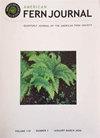跨越鸿沟:对生长在陆地、表生和表生栖息地的蕨类植物功能特征的探索
IF 0.9
4区 生物学
Q4 PLANT SCIENCES
引用次数: 0
摘要
摘要植物的特征是其显著的可塑性和改变其功能生物学以划分生态位的能力。然而,功能特征的探索是有限的,尤其是在复杂和紧张的栖息地。高度专业化的特征可能控制一个物种在栖息地内和跨栖息地探索的能力。附生植物尤其如此,它们的一系列独特特征可能会限制它们在附生和陆地栖息地交叉建立的能力。就蕨类植物而言,很少有物种能够在这些栖息地有规律地生长的报道。然而,这项研究报告并探索了在各种栖息地和生长形式中表现出巨大生态灵活性的物种。具体来说,我们研究了以下物种:1)陆地生根和附生个体,2)筑巢和不筑巢的附生植物;和形成巢穴的陆地扎根个体,以及3)作为陆地、附生和表生个体生长的物种。我们使用N15和C13以及%N的自然丰度-叶面稳定同位素比率(SIR)来探索不同生态位和生态位内矿物营养和水分关系的种内变化。我们的研究结果揭示了1)一些物种在附生/陆地分水岭上生长的能力,2)一些物种探索这些栖息地的能力令人惊讶,功能特征几乎没有变化;3) 这是巢中附生植物的一种潜在的新功能。最后,我们的工作强调,在研究分布在各种栖息地的蕨类植物时,需要更仔细地考虑种内性状的变化。本文章由计算机程序翻译,如有差异,请以英文原文为准。
Crossing the Divide: An Exploration of Functional Traits in Ferns that Grow Across Terrestrial, Epipetric, and Epiphytic Habitats
Abstract. Plants are characterized by their marked plasticity and ability to alter their functional biology to partition ecological niches. However, there are limits to functional trait exploration especially in complex and stressful habitats. Highly specialized traits may control a species ability to explore within and across habitats. Such may be especially true of epiphytes, whose array of unique traits may constrain their ability to cross establish in epiphytic and terrestrial habitats. In the case of ferns, there are few reported examples of species that can grow across these habitats with regularity. However, this study reports and explores species that exhibit great ecological flexibility growing across a wide range of habitats and growth forms. Specifically, we examine species that grow as 1) terrestrially rooted and epiphytic individuals, 2) nest and non-nest-forming epiphytes; and nest-forming terrestrially rooted individuals, and 3) species that grow as terrestrial, epiphytic, and epipetric individuals. We use natural abundance foliar stable isotope ratios (SIR) of N15 and C13, and %N, to explore intraspecific variation in mineral nutrition and water relations across and within niches. Our results reveal the 1) unreported ability of some species to grow across the epiphytic/terrestrial divide, 2) surprising ability of some species to explore these habitats with little to no shift in functional traits; 3) a potentially new function for the nest in nest-forming epiphytes. Finally, our work highlights the need to consider intraspecific trait variation more carefully when studying ferns that occur across a wide range of habitats.
求助全文
通过发布文献求助,成功后即可免费获取论文全文。
去求助
来源期刊

American Fern Journal
生物-植物科学
CiteScore
1.20
自引率
0.00%
发文量
28
审稿时长
6 months
期刊介绍:
The American Fern Journal is a peer-reviewed journal focused on the biology of ferns and lycophytes.
 求助内容:
求助内容: 应助结果提醒方式:
应助结果提醒方式:


